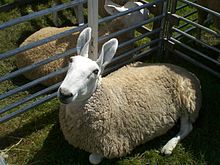Border Leicester
The Border Leicester is a breed of sheep that originated in England and is mainly bred for meat production. The sheep are hornless and have a long wool . Despite their size and robustness, they are meek. The sheep were also introduced for breeding in the USA , Australia and other countries.
In Great Britain the breed is listed as potentially endangered on the watch list of the British Rare Breeds Survival Trust .
description
When fully grown, the male sheep weigh between 140 and 175 kilograms, while the female weighs around 90 to 120 kilograms. Their white wool tends to get very long and is of the Merino standard, wide wavy (about 32 to 38 microns), and is used to make medium to heavy garments. Your wool will be longer than average and will pucker. When the wool is four inches long, it is sheared, usually twice a year. The wool is very popular because of its waviness and shine. The shearing of the lambs results in an average of 1.8 kg of wool, annual sheep up to 3.2 kg. The American, New Zealand and Australian sheep rarely have ears as rabbit-like as the British animals.
history
The Border Leicester sheep breed originated in Northumberland in 1767 . Their name is derived from the fact that their original home is near the border with Scotland, hence Border. The basis for this breed were the Dishley Leicester rams and the female sheep, which were either Teeswater or Cheviot sheep . The Dishley Leicester sheep was a breed of sheep developed by Robert Bakewell (1725–1795) through selective selection from local breeds, which were characterized by their early maturity and good meat approach.
Border Leicester were a very common breed in 19th century Britain.
International distribution
There are now registered herds in England, Ireland, Scotland and Wales. Border Leicester sheep were also exported to British Guiana , Canada , the People's Republic of China , Columbia , South Africa , France , Spain , Portugal , USA , India , Japan , Yugoslavia , Iran , Hungary , Russia , Turkey and Switzerland . Some of these sheep were introduced to Australia in 1871, where they now live in large herds.
Border Leicester rams are used to mate with merino sheep , the first cross ewes, which are particularly valuable for the offspring of high-class lambs. These cross-border Leicester Merino ewes offer the greatest economic benefit when raised for meat production. They have a well-proportioned body, high fertility, good food utilization and a high milk yield. Cross-border Leicester Merino ewes are paired with short-haired rams (such as Poll Dorset or Southdown) to produce lambs that grow rapidly to achieve ideal slaughter weight for sale. The vast majority of Australian lambs for meat production are bred this way. Border Leicester sheep make up approximately 50 percent of the pedigree of the breed of Gromark sheep, which were developed in Australia.
The breed first came to New Zealand in 1859, and again after the introduction of improved cooling in 1880. The Border Leicester were used for grafting and crossing to produce heavyweight lambs and mutton. They were also later used to develop New Zealand's Border-Cross Romney ( Coopworth ) and Border-Corriedale (Borderdale) breeds.
The first "race association" was founded in 1888 in the USA. There are currently two associations: the "American Border Leicester Association" and the "North American Border Leicester Association". Breeders show their sheep all year round at the county level and at trade shows and in the so-called "National Show" at the "North American International Livestock Exhibition" in Louisville, Kentucky, which takes place annually in November.
literature
- Philip Walling: Counting Sheep - A Celebration of the Pastoral Heritage of Britain . Profile Books, London 2014, ISBN 978-1-84765-803-6 .
Web links
- The Society for Border Leicester Sheep Breeders
- Australian Border Leicester Assoc.
- American Border Leicester Association
- NZ Border Leicester Assoc. ( Memento of October 8, 2009 in the Internet Archive )
Individual evidence
- ^ Border Leicester / United Kingdom. In: Breed Data Sheet. Domestic Animal Diversity Information System, accessed April 27, 2012 .
- ↑ Rare Breeds Survival Trust watchlist ( Memento of the original from May 4, 2015 in the Internet Archive ) Info: The archive link has been inserted automatically and has not yet been checked. Please check the original and archive link according to the instructions and then remove this notice. , accessed June 7, 2015
- ^ Robert Bakewell (1725-1795) . BBC History. Retrieved May 25, 2015.
- ↑ Philip Walling: Counting Sheep . P. 46.
- ↑ Carol Ekarius: Storey's Illustrated Breed Guide to Sheep, Goats, Cattle and Pigs . Storey Publishing, 2008, ISBN 978-1-60342-036-5 .
- ↑ Stephens, M ( et al. ): Handbook of Australian Livestock. Australian Meat & Livestock Export Corporation, 2000 (4th ed), ISBN 1-74036-216-0 .
- ^ Sheep breed compendium, Australian Wool Exchange (AWEX), 2010.
- ^ Border Leicester . In: Breeds of Livestock . Oklahoma State University Dept. of Animal Science. Archived from the original on March 18, 2012. Info: The archive link was automatically inserted and has not yet been checked. Please check the original and archive link according to the instructions and then remove this notice. Retrieved May 11, 2012.


